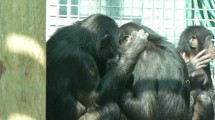Abstract
Hair plucking is observed in many captive primate species and is often characterized as an abnormal behavior. However, this behavior may be both self-directed and social and may have different etiologies. Early research in captive macaques (Macaca mulatta) described the aggressive nature of social hair plucking while more recent observations did not find an association with aggression or grooming, but the behavior was initiated most frequently by individuals with more secure dominance rank. Here, we investigate patterns of social hair plucking in a group of captive bonobos at the Columbus Zoo. We tested the hypothesis that social plucking reflects the dominance hierarchy by examining the association between social plucking and grooming, dominance, and kinship. We collected 128 h of grooming data on 16 captive bonobos using all-occurrence sampling. We ran three Mantel tests between a directed grooming matrix and (1) a plucking matrix, (2) a matrix reflecting dominance, and (3) matrix of relatedness. Grooming and hair plucking were significantly correlated (r = 0.25, p < 0.01), however, there was no association between plucking and dominance (r = − 0.04, p = 0.67), or plucking and relatedness (r = 0.07, p = 0.24). These results support the hypothesis that social plucking in bonobos is a grooming convention and is unrelated to dominance.


Similar content being viewed by others
References
Altmann J (1974) Observational study of behavior: sampling methods. Behaviour 49:227–267
Boose KJ, White FJ, Meinelt A (2013) Sex differences in tool use acquisition in bonobos (Pan paniscus). Am J Primatol 75:917–926
Brand CM, Marchant LF (2015) Hair plucking in captive bonobos (Pan paniscus). App Anim Behav Sci 171:192–196
Brand CM, Marchant LF (2018) Prevalence and characteristics of hair plucking in captive bonobos (Pan paniscus) in North American zoos. Am J Primatol 80:e22751
Brand CM, Boose KJ, Squires EC, Marchant LF, White FJ, Meinelt A, Snodgrass JJ (2016) Hair plucking, stress, and urinary cortisol among captive bonobos (Pan paniscus). Zoo Biol 35:415–422
Csardi G, Nepusz T (2006) The igraph software package for complex network research. InterJournal, Complex Systems, p 1695
de Waal FB, Seres M (1997) Propagation of handclasp grooming among captive chimpanzees. Am J Primatol 43:339–346
Franz C (1999) Allogrooming behavior and grooming site preferences in captive bonobos (Pan paniscus): association with female dominance. Int J Primatol 20:525–546
Hamilton WD (1964) The genetic evolution of social behavior II. J Theor Biol 7:1–52
Heagerty A, Wales RA, Prongay K, Gottlieb DH, Coleman K (2017) Social hair pulling in captive rhesus macaques (Macaca mulatta). Am J Primatol 79:e22720. https://doi.org/10.1002/ajp.22720
Hopper LM, Freeman HD, Ross SR (2016) Reconsidering coprophagy as an indicator of negative welfare for captive chimpanzees. App Anim Behav Sci 176:112–119
Hosey GR, Skyner LJ (2007) Self-injurious behavior in zoo primates. Int J Primatol 28:1431–1437
Kurland JA (1980) Kin selection theory: a review and selective bibliography. Ethol Sociobiol 1:255–274
Lutz C, Coleman K, Worlein J, Novak M (2013) Hair loss and hair pulling in rhesus macaques (Macaca mulatta). J Am Assoc Lab Anim Sci 52:454–457
McGrew WC, Tutin CEG (1978) Evidence for a social custom in wild chimpanzees? Man 13:234–251
McGrew WC, Marchant LF, Scott S, Tutin CEG (2001) Intergroup differences in a social custom of wild chimpanzees: the grooming hand-clasp of the Mahale Mountains, Tanzania. Curr Anthropol 42:148–153
Nakamura M (2002) Grooming-hand-clasp in Mahale M Group chimpanzees: implications for culture in social behaviours. In: Boesch C, Hohmann G, Marchant LF (eds) Behavioural diversity in chimpanzees and bonobos. Cambridge University Press, Cambridge, pp 71–83
Nakamura M, McGrew WC, Marchant LF, Nishida T (2000) Social scratch: another custom in wild chimpanzees? Primates 41:237–248
Nash LT, Fritz J, Alford PA, Brent L (1999) Variables influencing the origins of diverse abnormal behaviors in a large sample of captive chimpanzees (Pan troglodytes). Am J Primatol 48:15–29
O’Malley RC, Wallauer W, Murray CM, Goodall J (2012) The appearance and spread of ant fishing among the Kasekela chimpanzees of Gombe: a possible case of intercommunity cultural transmission. Curr Anthropol 53:650–663
Oksanen J, Guillaume Blanchet F, Friendly M, Kindt R, Legendre P, McGlinn D, Minchin PR, O’Hara RB, Simpson GL, Solymos P, Stevens MHH, Szoecs E, Wagner H (2019) Vegan: community ecology package. R package version 2.5-4. https://CRAN.R-project.org/package=vegan. Accessed 4 Feb 2019
R Core Team (2015) R: a language and environment for statistical computing. R Foundation for Statistical Computing, Vienna
Reinhardt V (2005) Hair pulling: a review. Lab Anim 39:361–369
Reinhardt V, Reinhardt A, Houser D (1986) Hair pulling and eating in captive rhesus monkey troops. Fol Primatol 47:158–164
Stevens JM, Wind S (2011) Regurgitation and reingestion in zoo-living bonobos (Pan paniscus): the influence of dietary changes. Am J Primatol 73(S1):108
Vervaecke H, De Vries H, Van Elsacker L (2000) The pivotal rank of rank in grooming and support behavior in a captive group of bonobos (Pan paniscus). Behaviour 137:1463–1485
Acknowledgements
We thank the Congo Expedition staff at the Columbus Zoo and Aquarium for their insight and support of this project, particularly Audra Meinelt. We also thank Frances White for recommendations on the data analysis. The manuscript was greatly improved with the suggestions from two anonymous reviewers. This study was approved by the Columbus Zoo and Aquarium. Funding was provided by the Rebecca Jeanne Andrew Memorial Award and the College of Arts and Science Dean’s Scholar Award, Miami University.
Author information
Authors and Affiliations
Corresponding author
Additional information
Publisher's Note
Springer Nature remains neutral with regard to jurisdictional claims in published maps and institutional affiliations.
Electronic supplementary material
Below is the link to the electronic supplementary material.
About this article
Cite this article
Brand, C.M., Marchant, L.F. Social hair plucking is a grooming convention in a group of captive bonobos (Pan paniscus). Primates 60, 487–491 (2019). https://doi.org/10.1007/s10329-019-00764-7
Received:
Accepted:
Published:
Issue Date:
DOI: https://doi.org/10.1007/s10329-019-00764-7




